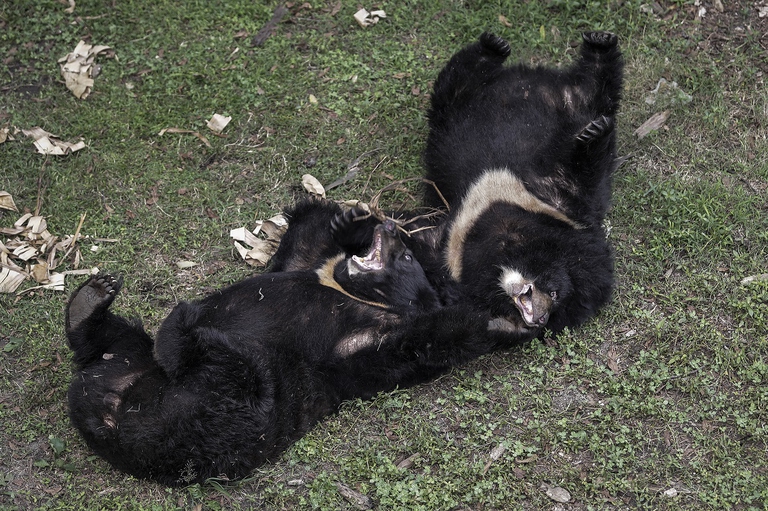
Our species took its first steps in a world covered in trees. Today, forests offer us sustenance, shelter, and clean the air that we breathe.
NGO Free the Bears has opened a mountain sanctuary for moon bears in Laos. With the government’s help, it aims to close all bile farms by 2022.
The life of thousands of Asian black bears (Ursus thibetanus), also known as moon bears because of the white patch on their chest, sounds like something out of a horror film. They spend most of their existence caged and exploited in bile farms, found in several Asian countries. Here they’re squeezed to obtain their bile, which contains ursodeoxycholic acid (UDCA), used in traditional Chinese medicine.
For many animals, this horrible suffering, which may last for up to thirty years, ends only with death. Some, however, are given a second chance, saved by organisations that are fighting to protect them. These bears are freed and transferred to specialised recovery centres. Free the Bears is one of those organisations: for 25 years it has tried to end these plantigrades’ suffering, with bear sanctuaries in three different countries.
Free the Bears, in collaboration with the Laos Department of Forestry, recently opened a large new bear sanctuary in Luang Prabang, in a wooded valley in the north of the country.
The Luang Prabang Wildlife Sanctuary is located in the same area as the previous one, but it’s 25 times larger and should be fully completed by 2021. The structure includes a wildlife hospital, a “nursery” for cubs, shelters for bears, an education centre and housing for volunteers. Moon bears are also allowed to roam freely inside a large enclosed area, which includes a lake where they can swim and fish.
In addition to bears, the sanctuary is designed to accommodate other species that fall victim to illegal wildlife trafficking, such as leopards, primates and birds of prey. A special structure has even been created to house pangolins that need care before they’re reintroduced into the wild.
“More than 20 different species, many of which are on the IUCN’s Red List, have been provided with a second chance at life thanks to the creation of this much-needed sanctuary,” says Free the Bears communications manager Rod Mabin.
The organisation, thanks to the support of the Laotian government, set itself the goal of closing down all bile farms in the country by 2022, and of transferring all saved bears to the new sanctuary.
The Covid-19 pandemic, however, might put a spanner in the works. China’s National Health Commission has in fact added Tan Re Qing injections to its list of treatments for the virus. This drug’s active ingredient is moon bear bile. “They use bear bile acid to treat gallstones and other liver diseases, but people need to understand there are more than 50 herbal and synthetic alternatives that will do the same job,” explains Free the Bears Technical Advisor Nikki Brow.
The effects of the global health emergency are also reflected in other aspects related to the protection of moon bears. Travel restrictions, for example, make it hard for veterinarians and volunteers to travel, and funding for conservation programmes is at risk of being significantly delayed.
Siamo anche su WhatsApp. Segui il canale ufficiale LifeGate per restare aggiornata, aggiornato sulle ultime notizie e sulle nostre attività.
![]()
Quest'opera è distribuita con Licenza Creative Commons Attribuzione - Non commerciale - Non opere derivate 4.0 Internazionale.
Our species took its first steps in a world covered in trees. Today, forests offer us sustenance, shelter, and clean the air that we breathe.
Poachers in Africa are encroaching on wildlife land and killing rhinos in travel hot spots now devoid of visitors due to the coronavirus pandemic.
Actor and environmental activist Leonardo DiCaprio has contributed two million dollars to a fund to protect Virunga National Park in Congo from threats such as terrorism, the coronavirus and poaching.
For the first time in seventeen years, Iceland’s two main whaling companies won’t resume whale hunting. The announcement concerns this year’s season but could carry into the future.
The relationship between the coronavirus and wildlife is complex: while the pandemic may lead to a reduction in the illegal trade in wild animals, it may also encourage it in other respects.
The largest coral reef in the world is severely threatened by climate change, but researchers are developing strategies that could contribute to saving the Great Barrier Reef.
Seychelles have extended its marine protected area, which now covers over 400,000 square kilometres, an area larger than Germany.
The tapir was reintroduced into Brazil’s Atlantic Forest, the country’s most at-risk ecosystem. The species can play a key role in the forest’s recovery.
One of Africa’s last and largest “tuskers”, Tim the elephant, died from natural causes after roaming Amboseli National Park for five decades and surviving multiple life-threatening attacks.








